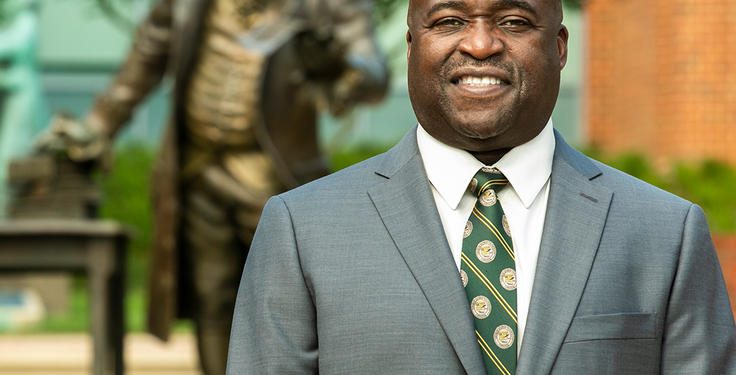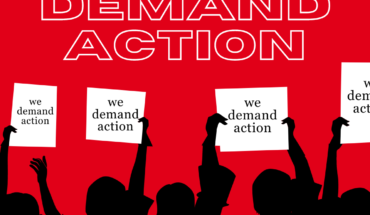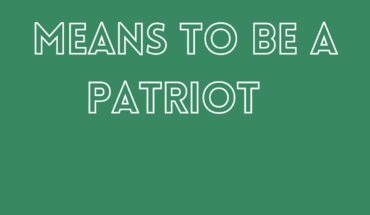Mason’s president speaks on work environment, COVID-19 updates and accomplishments
BY LIANNA BROWN AND SAMI GIBBS, CO-EDITORS-IN-CHIEF
Editor’s Note: This interview was edited for length and clarity. Sami Gibbs conducted the interview.
How do you think handling your first year as president impacted your vision for Mason, especially considering having to work through the pandemic?
Very little of what I wanted to do, I was able to do during my first year. The pandemic really forced us to change course. The reality of it is that in one sense it slowed us down because you’re not able to do all the great things you want, but in a second sense, it really helped us. It helped us because it helped me understand the dynamics of my team. I was hoping that we would be kind of done with the pandemic at this point, and we’re not. And so, we’re going to be dealing with a lot of this year, and even with the vaccines and even with the testing, even with our safety protocols, [which are] among the strongest in our state, and probably the strongest in our region. We do everything, we got surveillance testing, we got multiple testing even for people who are vaccinated, we have a vaccine requirement, we have many, many different protocols in place to keep people safe. And, how successful are we going to be? I don’t know. The Delta variant is a real unknown.
Previously your goal was to have 75 percent of classes in person. Students have been discussing that some of their in-person classes have changed recently to online. What is the update now? Do you think you’ll be able to achieve that goal with the Delta variant cases rising?
Some classes might move, but we are going to put in place really strong deterrents to move faculty away from doing that. I want students to reach out to the provost when their classes are moved online. There are 10,000 classes on our campus. Is there the possibility that some classes might be moved from in-person to online, and we do not know it? Yes. But, if students tell us, then we’ll know because our goal here is to only do that in extreme circumstances. That’s why we put the safety protocols in place. That’s why we were so aggressive with everything we’ve done up to this point–so that we could have a high percentage of our classes in-person. If you’re forcing a three-foot or a six-foot social distancing requirement, that means that physically, you can only get so many people in the classroom, and that means your large classes have to go online because there’s no facility large enough to accommodate the students. Or, you have to break that big class into multiple smaller classes. That’s the reality we are dealing with. My philosophy is, and has been that, when the conditions change, you change too. That is one of the things I’ve learned about my staff, is that we have people here, who can be flexible, who can change when the conditions change.
You’ve discussed a lot of the proactive protocols in place so that way we are able to have a safe return to Mason. In the instance that cases rise, is there a plan in place if we have to go back to online learning?
The reality is that there is a plan. We’ll cross that hurdle when we get to it. The good thing is, we went to an online framework from in-person with very little advance warning. Now we have all the protocols in place to do things in an online fashion. We can do it, much easier than we could when we had to make that transition in March [2020]. So, I’m not as concerned. We will do what is necessary to continue to keep the university operational and to keep people safe. [This] doesn’t mean we won’t have cases, this is a highly contagious variant. This does mean that we will respond to those in an appropriate manner.
Will there be a plan in place for providing financial aid and assistance for students who are impacted the most [if we return to remote learning]?
We do have a plan for providing financial aid. We will provide more aid whether we go through a shutdown or not. We have a plan to provide more aid to students, and we will work through that. Our goal here is to accommodate as many students as possible during this difficult time.
You have been vocal about your commitment to the student experience. In what ways do you think you have improved the faculty and staff work experience during your time here at Mason?
I can give you three. The first is that we have recognized in a very, very methodical way that our faculty are under-compensated, and we have put in place mechanisms to give faculty more support and more resources. That came in the manner of a 5 percent raise that we gave all of our faculty and staff this past year. The idea is that we know we have to play “catch up” in order to compensate our faculty like they should be compensated.
We are now looking at the modification of faculty benefits, including tuition accommodations for dependents of faculty and staff. Meaning, if your children come to school at Mason, we are working on a framework that would provide some level of tuition assistance. Currently, we don’t have that.
We are also looking at the overall faculty work environment, and we’re looking at ways in which we can put support mechanisms in place to improve the overall work environment for faculty. Even with our management of the pandemic, for faculty and staff, we do have one of the most flexible work policies [in Virginia]. People are not required to be here every day; they can do work from home up to one to two days a week. For the last eighteen months, everyone has been working from home 100 percent, and to move them back to work on campus 100 percent, might be difficult for some people, so we have this mechanism in place. Oftentimes we forget about staff when we’re thinking about these programs. We think of students and we think about their faculty, but the reality is that the campus could not operate without the students, faculty or staff. You need all three in order for the campus to function.
You mentioned that you’re providing flexibility on the percentage of in-person work, can you just give more examples on ways you are going to improve the work environment for faculty and staff?
I can’t give you specific examples because we’re doing a comprehensive review of the workplace for both faculty and staff, and a lot of that will take place this year. We’re really relying heavily on the faculty setting to help us understand faculty needs in a much more aggressive way. Our partnership with the faculty senate is continuing to grow and expand in unprecedented ways. The partnership with the faculty senate and the administration has been adversarial for years, but we have started a mechanism to change that adversarial relationship into one that’s more collaborative. We won’t always agree on every direction, but the idea is for us to have a very high level of communication and engagement. We actually had a facilitated retreat for the first time this year where we took the top leaders in the faculty senate, and the top leaders in my administration and we sat down together in a room all day. We talked about our biggest challenges and issues and out of that, here came a mechanism, a framework for how we were going to work together this year. And then the final point that will improve the work environment, and this is incredibly important, is that we have an Office of the Ombudsman. And what the office does is resolve disputes, they resolve conflicts. You can go to that arbitrator and both sides can lay out their issues, and then the arbitrator who is not representing one side or another can now render an outcome for the unit to live by–that’s huge for us because it will help us resolve conflicts that were not resolvable previously.
One of the things you did accomplish was the Early Identification Program and the Advance Program. What are the advancements on that? Can we get an update on that now?
Well, we are working on expanding both of those programs. They are two of our high priorities moving forward. We want to expand our Advance Program to not only accommodate more students, but also to accommodate additional institutions. We want to expand our Early Identification Program by three times larger today. Those are big rocks for us.
You established the Anti-Racism task force. Their website highlights things they have accomplished. How do you think that is going to be returning back to in-person?
The work is going to continue. I don’t expect the tenor of that to change now that we are in-person. The goal is to make Mason one of the most inclusive institutions in our country. We have a start and mechanisms put in place to help us do that. We can already say that when you come to Mason, your level of success doesn’t change much based on who you are. Whether you’re African-American, Latino, Caucasian, Asian–we all graduate at the undergraduate level at about the same rate. Most universities in the country can’t say that. They cannot. There is disparity. Some groups graduate at a high level and some groups do not. That is not the case at Mason. That is a disparity. We want to build upon that.
What is your biggest regret or misjudgment during your time as President so far?
Well look, I don’t really have a regret. There are lots of things where I wish we would have communicated better. I think we could have communicated better how we were rolling out our pre-testing mechanism for students. I think we could have communicated better some of the challenges we had in getting the vaccination programs running with the state. We were not perfect in that regard. That being said, we gave more than 90,000 vaccines. For a university without a hospital, that is a big deal. We had external clinics operating at Prince William county. Most of the vaccines we gave were not to Mason faculty, staff, and students, so we provided a tremendous service to our students. This is a time to be proud of Mason and I am really proud of what this institution has done.
What do you think is your biggest accomplishment so far as President?
You’re safe. My biggest accomplishment over the last year is that you are safe. We did not have the massive outbreaks that many of our Virginia peers had. They had hundreds of cases per week. We had a few hundred cases a semester. We had institutions that had 600 cases in a weekend, which was more than we had in the whole semester. We kept the campus safe and we did it without massive job loss. We maintained individuals’ jobs and we maintained a high-quality education for our students. So that was the big outcome, that we are able to do. And we had a line of smaller things that we had to do in order for it to be successful. We got $31 million in annual funds from the state–that took more than 200 individual meetings with elected officials. We got a new building expanded on our Prince William campus that took many meetings with many individuals. There are a whole host of smaller things. Putting protocols in place for testing and vaccination took discussions with the National Institutes of Health. All of the infrastructures had to be developed and we had to do it on the fly. When I told you, ‘we kept you safe,’ there were probably another 150 to 200 different smaller programs and initiatives that had to happen successfully in order to make that happen. So that is a huge accomplishment for this campus.




